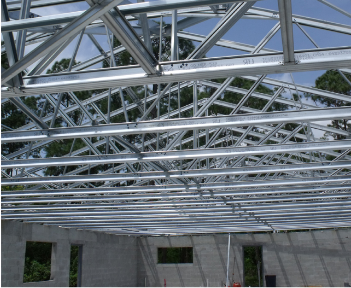Very large locking force.
In the force diagram of the force, when the axial locking normal thread and the dentition thread are compared with the force F, the normal force of the shank thread connection: the normal force of the common thread connection Therefore, in the case of the axial load, ie F, the anti-loose performance of the variable-toothed threaded joint and its application in port machinery, the second navigation engineering survey and design institute, Yuan Zongxi, Wu Tao, Wuhan University of Technology, Logistics Based on the analysis of the eccentric thread structure and the anti-loose principle, the School of Engineering has built an elastoplastic finite element analysis model based on ANSYS finite element software, analyzed the force of the dentition thread, and explained its anti-loose mechanism. , verified its anti-loose performance.
Preface Threaded joints are the most common type of fastener connection, but under impact, severe vibration or variable load, failure will occur, resulting in failure or damage to mechanical equipment.
In order to solve the problem of automatic loosening of the threaded joint, scholars have proposed various methods such as spring washers, counter-nuts, and retaining washers, but the actual effect is not satisfactory. In the 1970s, American engineers proposed a new type of threaded structure, a variable-toothed thread, which fundamentally solved the loosening problem of threaded fasteners. In 2000, this new type of product began to enter the Chinese railway industry. At present, this variable-shaped thread is widely used in large-scale equipment such as trains, airplanes, and tanks with high-speed operation and strong vibration. It also plays an important role in port machinery. Character. In this paper, the variable-toothed threaded nut provided by a company in Shanghai is taken as the research object, and the principle and performance of its anti-loose and anti-vibration are analyzed in detail.
1 varnished thread structure and its force analysis anamorphic thread is a wedge-shaped bevel on the thread of the female thread, the angle of the bevel can be a variety of options, the use of 30 ° angle. When the bolt and the nut are tightened to each other, the tip of the bolt will closely abut against the wedge-shaped inclined surface of the variable-shaped thread, so that the yield can be obtained. When the same, the larger the frictional force is.
This shows that when subjected to the same axial load, the variable-toothed threaded joint has more friction than the ordinary threaded joint, so that the joint between the threads is more firm and is not easy to loosen.
2Finite element modeling of variable-toothed threaded joint In order to verify the anti-loosening performance of the variable-toothed threaded joint, an elastic-plastic finite element analysis model was established in AN-SYS. Due to the spiral surface contact problem of the threaded bolt and nut, and the sinuous thread contact is a spiral contact, it is not easy to accurately align the three-dimensional model when establishing the three-dimensional model. Therefore, this paper uses the 2-D contact in ANSYS to simulate the Problem, a cross-sectional model of the bolt and nut was established.
2.1 Research Objects and Parameters The research object of this paper is the matching of the argon-type threaded nut with a pitch of -8 produced by a company in Shanghai and the standard bolt, and a cross-section model is established.
2.2 Definition of unit and material properties The material properties defined in this paper are shown in Table 1.
Table i material property table elastic modulus Poisson's ratio yield stress tangent modulus friction coefficient When building the model, this paper uses the two-dimensional 8-node unit PLANE82 unit in ANSYS, this unit has creep, plasticity, stress stiffness, radiation The ability to expand, strain, and deform. The parameters of the PLANE 82 unit are shown in Table 2. Table 2 The parameter table of the unit PLANE82 The dimension of the dimension The number of nodes The degree of freedom The quadrilateral 2.3 The model mesh Because the axial load distribution of the threaded connection has little to do with the mesh density, the coarse mesh can be used. For analysis, it is only necessary to refine the mesh in contact and where high stresses may occur. In this paper, a thicker mesh is used for the bolt body and the nut, and the mesh is refined at the thread and its contact (see), which can optimize the calculation speed and obtain relatively accurate calculation results. See the common threaded joint model established in ANSYS. The bolt model has 2689 units in section and the variable nut model has 1639 units in section.
2.4 Boundary condition definition The boundary conditions of this analysis are defined as follows according to the analysis of the thread joint receiving force: the bolt tip is fixed, the side edge of the bolt is symmetrically restrained, the side edge of the nut is set to the X direction displacement limit, and the axial end of the nut is applied with the axial load of the fastening part P. This analysis takes P = 10MPa. See the boundary conditions in ANSYS.
To simulate the contact between the bolt and the nut, this analysis uses the CON-TA 172 and TARGE169 units to simulate the contact and target faces, respectively. Both of these units have no thickness and can simulate large deformation problems with friction and large slip.
Since the variable-toothed threaded joint is the contact between the top of the bolt thread and the inclined surface of the nut thread, the bolt and the nut are made of a uniform material. According to the selection principle of the target surface and the contact surface, the bolt thread surface (ie, convex surface) will be defined. For the contact surface, the nut thread surface (ie the plane) is the target surface. See the contact settings between the threads in this analysis.
3 Finite element analysis results In ANSYS, the finite element elastoplastic analysis of the model can be used to obtain a synthetic stress cloud map. As can be seen from the figure, the stress distribution at each thread is almost the same. The maximum stress values ​​at each thread were extracted from ANSYS to obtain the results shown in Table 3.
Table 3 Maximum stress value at each thread contact / MPa load 1 As can be seen from Table 3, the maximum stress values ​​of the five thread contact positions are similar, and the stress is evenly distributed over all the thread teeth. This is because when the thread tip of the bolt is in contact with the dentition thread, the tip of the crown is prone to different degrees of deformation, and the deformation causes the load to be evenly distributed over the length of the full spiral of the thread contact, thereby improving the common thread. The phenomenon of load concentration on the first thread improves the reliability of the joint by minimizing possible thread shear damage.
The axial force and normal force data at each thread are extracted from the calculation results, as shown in Table 4. From the data in the table, it is easy to see that when subjected to axial load, the axial force of the variable-shaped thread is much smaller than its normal force, so it has a larger friction between the threads, making the threaded connection more reliable and less difficult. Loose.
Table 4: axial force versus radial force at each thread contact / N thread position axial force normal force On the other hand, since the shank thread is different from the ordinary thread, the thread is tightly fitted and there is no radial gap. And the radial load is much larger than its axial locking force, so it can resist the more severe lateral vibration, ensuring that the variable-toothed thread can still remain loose in the vibrating environment, ensuring the safety and reliability of the joint.
4 The application of variable-toothed thread technology in port machinery Since the advent of the variable-thread technology, it has attracted much attention and has been applied in large machinery in various industries. Mechanisms, machinery or parts such as spreaders, trolleys, brakes, and carts on port machinery are subject to large vibration loads during operation, especially on the spreader guides of container cranes. At the moment when the crane lifts and lowers the container, the modified plate will undergo considerable impact and strong vibration, so the anti-vibration performance of the threaded fastener is more demanding. Engineers have used a variety of auxiliary locking methods to achieve the desired anti-loose effect.
During the use of port machinery, loose threading problems have seriously affected the efficiency and safety of production. The use of variable-toothed threads fundamentally solves this technical problem. At present, many companies including Zhenhua Port Machinery have adopted variable-tooth thread technology to ensure the safety and efficiency of port production, while reducing the maintenance time of machinery and greatly improving the efficiency.
5 Conclusion In this paper, based on the analysis of the dentition thread structure and the anti-loose principle, the elastoplastic finite element analysis model is established based on ANSYS finite element software, and the force of the dentition thread is analyzed. The conclusion is as follows: The force of the toothed thread is evenly distributed at each thread contact position, which improves the phenomenon that the ordinary thread load is concentrated on the first thread.
The normal force between the threads of the variable-toothed thread is much larger than the axial locking force, thus providing a large inter-thread friction and a significant anti-loose effect.
Due to the tight fit of the anamorphic thread, there is almost no gap between the threads, and because it has a larger radial force, it can resist lateral vibration and is therefore more difficult to loosen in a vibrating environment.
The variable-toothed threaded joint is widely used in port machinery and has a good anti-loosening effect during use. Its application prospect in the vibration environment can not be underestimated.
zhongda steel church building with brick exteriorExperience: zhongda has delivered thousands of steel buildings all across North America. We have years of knowledge designing and constructing steel church buildings.
Quality: zhongda prefabricated church buildings offer premium grade materials and other exceptional benefits not included with other systems. Our heavy-gauge steel roof and metal building panels, for example, provide greater strength by overlapping the panels more fully, where other building systems do not. Our standard features also include many other features, like die-formed ridge caps, formed base trim, closure strips, and matching cover trim for all door and window openings.




Prefab Steel Building,Metal House Kits,Metal Building Houses,Prefab Steel Buildings
Zhongda Steel Structure , https://www.zhongdametal.com